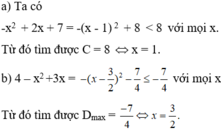
Hãy nhập câu hỏi của bạn vào đây, nếu là tài khoản VIP, bạn sẽ được ưu tiên trả lời.


\(1.\)
\(-17-\left(x-3\right)^2\)
Ta có: \(\left(x-3\right)^2\ge0\)với \(\forall x\)
\(\Leftrightarrow-\left(x-3\right)^2\le0\)với \(\forall x\)
\(\Leftrightarrow17-\left(x-3\right)^2\le17\)với \(\forall x\)
Dấu '' = '' xảy ra khi:
\(\left(x-3\right)^2=0\)
\(\Leftrightarrow x-3=0\)
\(\Leftrightarrow x=3\)
Vậy \(Max=-17\)khi \(x=3\)
\(2.\)
\(A=x\left(x+1\right)+\frac{3}{2}\)
\(A=x^2+x+\frac{3}{2}\)
\(A=\left(x+\frac{1}{2}\right)^2+\frac{5}{4}\)
\(\left(x+\frac{1}{2}\right)^2+\frac{5}{4}\ge\frac{5}{4}\)với \(\forall x\)
\(\Leftrightarrow\left(x+\frac{1}{2}\right)^2+\frac{5}{4}\ge\frac{5}{4}\)với \(\forall x\)
Vậy \(Max=\frac{5}{4}\)khi \(x=\frac{-1}{2}\)

B3:\(\Rightarrow90.10^n-10^n.10^2+10^n.10-20\Rightarrow10^n.\left(90-10^2\right)+10^n.10-20\)
\(\Rightarrow10^n.\left(90-100\right)+10^n.10-20\Rightarrow-10.10^n+10^n.10-20\Rightarrow-20\)
\(A=-\left(x^2-x+5\right)=-\left(x^2-2.\frac{1}{2}x+\frac{1}{4}+\frac{19}{4}\right)=-\left[\left(x-\frac{1}{2}\right)^2+\frac{19}{4}\right]\)
\(=-\left(x-\frac{1}{2}\right)^2-\frac{19}{4}\le-\frac{19}{4}\)
Vậy \(A_{min}=-\frac{19}{4}\Leftrightarrow x-\frac{1}{2}=0\Rightarrow x=\frac{1}{2}\)

Lời giải:
a.
$C=16-3(x^2+4x+4)=16-3(x+2)^2$
Vì $(x+3)^2\geq 0$ với mọi $x\in\mathbb{R}$
$\Rightarrow C\leq 16-3.0=16$
Vậy $C_{\max}=16$ khi $x=-2$
b.
$D=-x^2+5x=2,5^2-(x^2-5x+2,5^2)$
$=6,25-(x+2,5)^2\leq 6,25-0=6,25$
Vậy $D_{\max}=6,25$ khi $x=-2,5$
c.
$M=2x-x^2=1-(x^2-2x+1)=1-(x-1)^2\leq 1-0=1$
Vậy $M_{\max}=1$ khi $x=1$
a: Ta có: \(C=-3x^2-12x+4\)
\(=-3\left(x^2+4x-\dfrac{4}{3}\right)\)
\(=-3\left(x^2+4x+4-\dfrac{16}{3}\right)\)
\(=-3\left(x+2\right)^2+16\le16\forall x\)
Dấu '=' xảy ra khi x=-2
b: Ta có: \(D=-x^2+5x\)
\(=-\left(x^2-5x+\dfrac{25}{4}\right)+\dfrac{25}{4}\)
\(=-\left(x-\dfrac{5}{2}\right)^2+\dfrac{25}{4}\le\dfrac{25}{4}\forall x\)
Dấu '=' xảy ra khi \(x=\dfrac{5}{2}\)

Answer:
a) \(\frac{5x}{2x+2}+1=\frac{6}{x+1}\)
\(\Rightarrow\frac{5x}{2\left(x+1\right)}+\frac{2\left(x+1\right)}{2\left(x+1\right)}=\frac{12}{2\left(x+1\right)}\)
\(\Rightarrow5x+2x+2-12=0\)
\(\Rightarrow7x-10=0\)
\(\Rightarrow x=\frac{10}{7}\)
b) \(\frac{x^2-6}{x}=x+\frac{3}{2}\left(ĐK:x\ne0\right)\)
\(\Rightarrow x^2-6=x^2+\frac{3}{2}x\)
\(\Rightarrow\frac{3}{2}x=-6\)
\(\Rightarrow x=-4\)
c) \(\frac{3x-2}{4}\ge\frac{3x+3}{6}\)
\(\Rightarrow\frac{3\left(3x-2\right)-2\left(3x+3\right)}{12}\ge0\)
\(\Rightarrow9x-6-6x-6\ge0\)
\(\Rightarrow3x-12\ge0\)
\(\Rightarrow x\ge4\)
d) \(\left(x+1\right)^2< \left(x-1\right)^2\)
\(\Rightarrow x^2+2x+1< x^2-2x+1\)
\(\Rightarrow4x< 0\)
\(\Rightarrow x< 0\)
e) \(\frac{2x-3}{35}+\frac{x\left(x-2\right)}{7}\le\frac{x^2}{7}-\frac{2x-3}{5}\)
\(\Rightarrow\frac{2x-3+5\left(x^2-2x\right)}{35}\le\frac{5x^2-7\left(2x-3\right)}{35}\)
\(\Rightarrow2x-3+5x^2-10x\le5x^2-14x+21\)
\(\Rightarrow6x\le24\)
\(\Rightarrow x\le4\)
f) \(\frac{3x-2}{4}\le\frac{3x+3}{6}\)
\(\Rightarrow\frac{3\left(3x-2\right)-2\left(3x+3\right)}{12}\le0\)
\(\Rightarrow9x-6-6x-6\le0\)
\(\Rightarrow3x\le12\)
\(\Rightarrow x\le4\)

b) B=-3(x^2-3x+9/4)+27/4=-3(x-3/2)^2+27/4 <=27/4. Vậy MaxB=27/4, dấu "=" xảy ra <=> x-3/2=0 <=> x=3/2
a, Ta có : \(A=2x^2-8x-10=2\left(x^2-4x-5\right)\)
\(=2\left(x^2-4x+4-9\right)=3\left(x-2\right)^2-18\ge-18\)
Dấu ''='' xảy ra <=> x = 2
Vậy GTNN A là -18 <=> x = 2

\(2x-3x^2+4\)
\(=-3\left(x^2-\frac{3}{2}x-\frac{4}{3}\right)\)
\(=-3\left(x^2-2.x.\frac{3}{4}+\frac{9}{16}-\frac{91}{48}\right)\)
\(=\frac{91}{16}-3\left(x^2-\frac{3}{4}\right)^2\le\frac{91}{16}\)
Max = \(\frac{91}{16}\Leftrightarrow x^2-\frac{3}{4}=0\Rightarrow x^2=\frac{3}{4}\Rightarrow x=\sqrt{\frac{3}{4}}\)

a) Giá trị lớn nhất:
\(A=2x-3x^2-4=-3\left(x^2-\frac{2}{3}x+\frac{4}{3}\right)=-3\left[x^2-2.x.\frac{1}{3}+\left(\frac{1}{3}\right)^2+\frac{35}{9}\right]=-3\left(x-\frac{1}{3}^2\right)-\frac{35}{3}\)
Vì \(\left(x-\frac{1}{3}\right)^2\ge0\left(x\in R\right)\)
Nên \(-3\left(x-\frac{1}{3}\right)^2\le0\left(x\in R\right)\)
do đó \(-3\left(x-\frac{1}{3}\right)^2-\frac{35}{3}\le-\frac{35}{3}\left(x\in R\right)\)
Vậy \(Max_A=-\frac{35}{3}\)khi \(x-\frac{1}{3}=0\Rightarrow x=\frac{1}{3}\)
\(B=-x^2-4x=-\left(x^2+4x\right)=-\left(x^2+2.x.2+2^2-2^2\right)=-\left(x+2\right)^2+4\)
Vì \(\left(x+2\right)^2\ge0\left(x\in R\right)\)
nên \(-\left(x+2\right)^2\le0\left(x\in R\right)\)
do đó \(-\left(x+2\right)^2+4\le4\left(x\in R\right)\)
Vậy \(Max_B=4\)khi \(x+2=0\Rightarrow x=-2\)
b) Giá trị nhỏ nhất
\(A=x^2-2x-1=x^2-2.x.+1-2=\left(x-1\right)^2-2\)
Vì \(\left(x-1\right)^2\ge0\left(x\in R\right)\)
nên \(\left(x-1\right)^2-2\ge-2\left(x\in R\right)\)
Vậy \(Min_A=-2\)khi \(x-1=0\Rightarrow x=1\)
\(B=4^2+4x+5=\left(2x\right)^2+2.2x.1+1+4=\left(2x+1\right)^2+4\)
vì \(\left(2x+1\right)^2\ge0\left(x\in R\right)\)
nên \(\left(2x+1\right)^2+4\ge4\left(x\in R\right)\)
Vậy \(Min_B=4\)khi \(2x+1=0\Rightarrow x=-\frac{1}{2}\)
